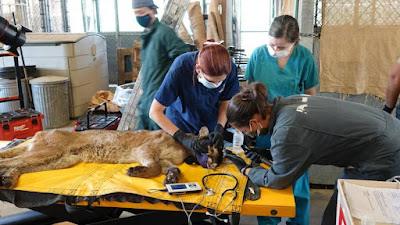Photograph: Chelsea Stein Engberg/Courtesy of Gold Country Wildlife Rescue
I just read a fascinating article in The Guardian online newspaper about the Wildlife Disaster Network. This organization is a partnership between the UC Davis School of Veterinary Medicine and the California Department of Fish and Wildlife. This
group of volunteer disaster veterinarians is currently treating animals injured in California’s
devastating wildfires. It usually gets calls from first responders located in fire zones,
and then requests authorization from officials to go look for
injured wildlife. Once captured, the animals are transported to
animal rescue facilities where they sometimes spend months receiving
treatments and recovering from their injuries.
“It [Wildlife Disaster Network] aims to quickly and efficiently mobilize the people and resources needed to aid wildlife affected by wildfire and other disasters. The Wildlife Disaster Network includes veterinarians, wildlife biologists, ecologists, trained animal care volunteers and rehabilitation centers. It involves field reconnaissance in the aftermath of fires, conducted by UC Davis-affiliated staff, with the approval and oversight of Incident Command, when conditions are deemed safe to do so.
Photograph: California Department of Fish & Wildlife
Simply locating the animals, though, is often a grueling, time-consuming task. Some of their days involve hiking 10 to 15 hours through waist-deep ash into the red zone.
Photograph: California Department of Fish & Wildlife
Recently, the Wildlife Disaster Network went to find a bear cub, who was injured in the 700,000 acre (283,000 hectare) Dixie fire. Using binoculars, they spotted him up in a tree about a half mile from where firefighters had initially seen him near Taylorsville.
Photograph: California Department of Fish & Wildlife
The orphaned bear cub from the Dixie fire was admitted to Gold Country Wildlife Rescue, and is receiving IV fluids and veterinarians are treating its second and third degree burns with medical grade manuka honey. They’re optimistic about his recovery. He hasn’t had much of an appetite, the rescue says, but enjoys cantaloupe.”
Gold Country Wildlife Rescue, in Auburn, CA, is a nonprofit that rehabilitates and releases wounded wildlife. It is currently treating multiple animals rescued from wildfire zones along with the birds, squirrels and foxes in its care that weren’t injured in fires. Right now it is caring for two bear cubs, including the orphan from the Dixie fire, and a bobcat injured in the Lava fire.
For two summers I volunteered at the Wildlife Rehabilitation & Release intake center in Grass Valley, mainly taking care of injured songbirds. It was an incredible experience! This organization works closely with Gold Country Wildlife Rescue. Due to family circumstances, I couldn’t volunteer this summer. However, I am donating my art (see images above) to an art auction/fundraiser at the intake center on September 25, from 6:00-9:00 pm. This fundraiser is open to the public. Please come if you can! If you are interested in purchasing any of my art prints, please email me at northyubanaturalist@gmail.com.
If you are interested in donating to any of these wildlife
organizations please use the following links:
Wildlife Disaster Network (Davis, CA) – (530) 752-7024 https://give.ucdavis.edu/VWHC/V670WDN
Gold Country Wildlife Rescue (Auburn, CA) – (530) 885-0862
Wildlife Rehabilitation & Release (Grass Valley, CA) – (530) 477-5774
US Forest Service Extends Closure
of National Forests
The Tahoe National Forest, as well as 8 other National Forests in California have extended their forest closures until September 17. No driving, hiking, camping, fishing, swimming, boating or recreating is allowed. Anyone breaking this closure may be fined $5,000!!! I still think this is a great idea. Less people = less chance for wildfires. So stay home and prevent wildfires! I imagine the closures will continue even longer if we don't get any rain.
Red-shouldered Hawk in the Rain - 2019
Buteo lineatus
Damp Earth Art
The two, local, major fires, the Dixie/Jarbo Gap and the Caldor, have diminished a little. Fingers crossed that they continue to diminish. I am so grateful that there aren't any fires in our immediate area. My heart goes out to those who have lost their homes in this unprecedented fire season. My unending thanks go to the fire fighters who continue to battle these dangerous fires every day.
I so wish it would rain! We can't do anything about the drought, the wind, hot temperatures and fires. Worry makes it harder to bear. So anytime I think of it, I think rain, rain, rain. My intention is to focus on the need for rain, and through collective positive energy invoke rain to fall. It is just a wish, a thought, and a hope. I've created a blog, dampearthart.blogspot.com, where I post photographs, quotes, and artworks that feature rain.
Wood Duck female and duckling - 7/05/21
Aix sponsa
Pond Update!
Okay, the local ponds surprisingly still have a few waterfowl! The pond closest to me has a few juvenile Wood Ducks and Mallards, and the water is quite low. The Charles Marsh Pond has a few Mallards, and is filling up with pond weeds. I haven't been able to visit the Wood Duck Pond so I don't know its status.
What's happening on the river?
What are "close-focus" binoculars?
Check back next week for the answers to these questions and more.
Unfortunately, you can no longer sign up to get my blog via email. Just go to northyubanaturalist.blogspot.com directly. It looks better than the emailed version!
Your questions and comments are greatly appreciated. Please feel free to email me at northyubanaturalist@gmail.com. Thanks!









No comments:
Post a Comment